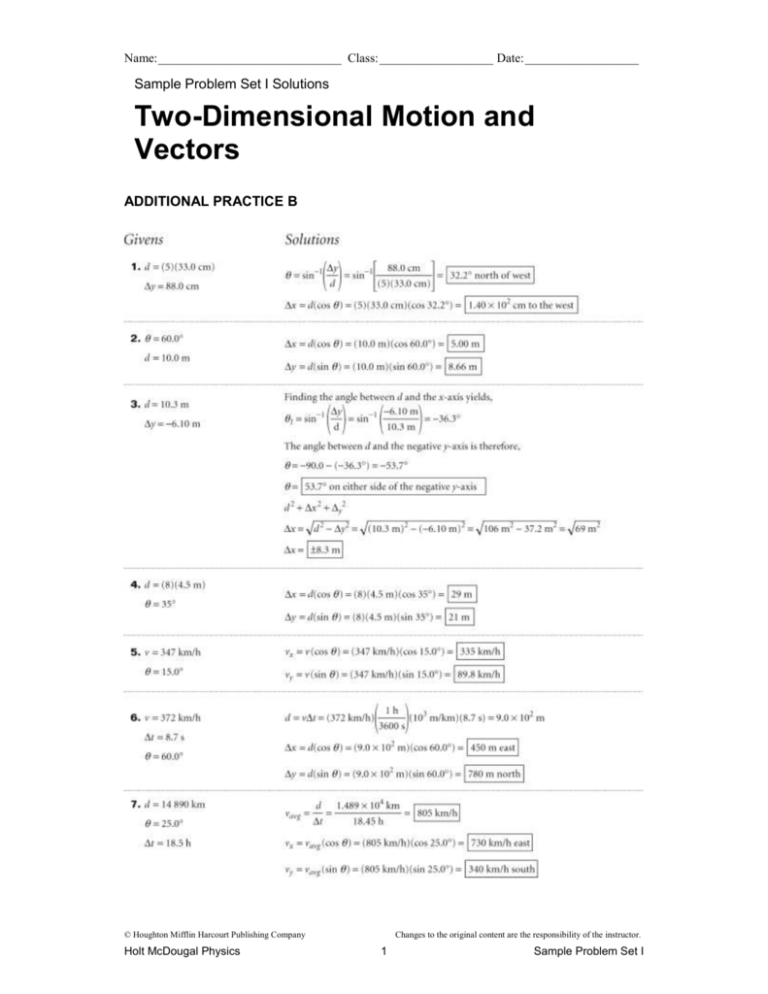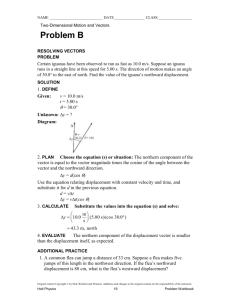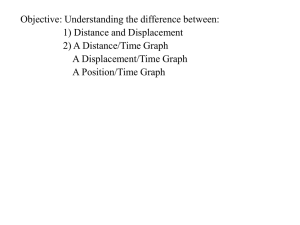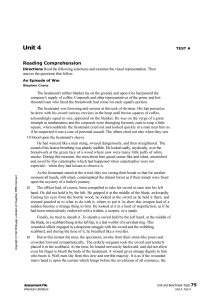2D Motion & Vectors Problem Set Solutions
advertisement

Name: _____________________________ Class: __________________ Date: __________________ Sample Problem Set I Solutions Two-Dimensional Motion and Vectors ADDITIONAL PRACTICE B © Houghton Mifflin Harcourt Publishing Company Holt McDougal Physics Changes to the original content are the responsibility of the instructor. 1 Sample Problem Set I Name: _____________________________ Class: __________________ Date: __________________ © Houghton Mifflin Harcourt Publishing Company Holt McDougal Physics Changes to the original content are the responsibility of the instructor. 2 Sample Problem Set I Name: _____________________________ Class: __________________ Date: __________________ Two-Dimensional Motion and Vectors Problem B RESOLVING VECTORS PROBLEM Certain iguanas have been observed to run as fast as 10.0 m/s. Suppose an iguana runs in a straight line at this speed for 5.00 s. The direction of motion makes an angle of 30.0 to the east of north. Find the value of the iguana’s northward displacement. SOLUTION 1. DEFINE Given: v = 10.0 m/s t = 5.00 s = 30.0 Unknown: y = ? Diagram: 2. PLAN Choose the equation (s) or situation: The northern component of the vector is equal to the vector magnitude times the cosine of the angle between the vector and the northward direction. y = d(cos ) Use the equation relating displacement with constant velocity and time, and substitute it for d in the previous equation. d = vt y = vt(cos ) 3. CALCULATE Substitute the values into the equation (s) and solve: m y 10.0 (5.00 s)(cos 30.0) s 43.3 m, north 4. EVALUATE The northern component of the displacement vector is smaller than the displacement itself, as expected. ADDITIONAL PRACTICE 1. A common flea can jump a distance of 33 cm. Suppose a flea makes five jumps of this length in the northwest direction. If the flea’s northward displacement is 88 cm, what is the flea’s westward displacement? © Houghton Mifflin Harcourt Publishing Company Holt McDougal Physics Changes to the original content are the responsibility of the instructor. 3 Sample Problem Set I Name: _____________________________ Class: __________________ Date: __________________ 2. The longest snake ever found was a python that was 10.0 m long. Suppose a coordinate system large enough to measure the python’s length is drawn on the ground. The snake’s tail is then placed at the origin and the snake’s body is stretched so that it makes an angle of 60.0 with the positive x-axis. Find the x and y coordinates of the snake’s head. (Hint: The y-coordinate is positive.) 3. A South-African sharp-nosed frog set a record for a triple jump by traveling a distance of 10.3 m. Suppose the frog starts from the origin of a coordinate system and lands at a point whose coordinate on the y-axis is equal to 6.10 m. What angle does the vector of displacement make with the negative y-axis? Calculate the x component of the frog. 4. The largest variety of grasshopper in the world is found in Malaysia. These grasshoppers can measure almost a foot (0.305 m) in length and can jump 4.5 m. Suppose one of these grasshoppers starts at the origin of a coordinate system and makes exactly eight jumps in a straight line that makes an angle of 35 with the positive x-axis. Find the grasshopper’s displacements along the x- and y-axes. Assume both component displacements to be positive. 5. The landing speed of the space shuttle Columbia is 347 km/h. If the shuttle is landing at an angle of 15.0 with respect to the horizontal, what are the horizontal and the vertical components of its velocity? 6. In Virginia during 1994 Elmer Trett reached a speed of 372 km/h on his motorcycle. Suppose Trett rode northwest at this speed for 8.7 s. If the angle between east and the direction of Trett’s ride was 60.0, what was Trett’s displacement east? What was his displacement north? 7. The longest delivery flight ever made by a twin-engine commercial jet took place in 1990. The plane covered a total distance of 14 890 km from Seattle, Washington to Nairobi, Kenya in 18.5 h. Assuming that the plane flew in a straight line between the two cities, find the magnitude of the average velocity of the plane. Also, find the eastward and southward components of the average velocity if the direction of the plane’s flight was at an angle of 25.0 south of east. 8. The French bomber Mirage IV can fly over 2.3 103 km/h. Suppose this plane accelerates at a rate that allows it to increase its speed from 6.0 102 km/h to 2.3 103 km/h in a time interval of 120 s. If this acceleration is upward and at an angle of 35 with the horizontal, find the acceleration’s horizontal and vertical components. © Houghton Mifflin Harcourt Publishing Company Holt McDougal Physics Changes to the original content are the responsibility of the instructor. 4 Sample Problem Set I









